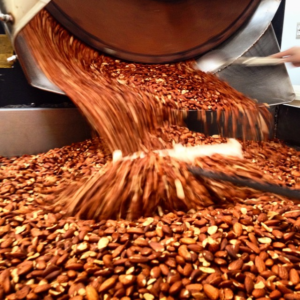
Posted on : May 17th, 2017
 When you pick up your fresh bag of almonds or scoop that first teaspoon from the brand new almond butter jar, the last thing you’ll think about is the way those almonds were processed. But today, especially in our food conscious society, it’s important to know not only what you’re getting in your food, but how you’re getting it.
When you pick up your fresh bag of almonds or scoop that first teaspoon from the brand new almond butter jar, the last thing you’ll think about is the way those almonds were processed. But today, especially in our food conscious society, it’s important to know not only what you’re getting in your food, but how you’re getting it.
Food processing is a taboo phrase that makes you cringe and picture rows of boxed food or drive-through hamburgers that don’t grow mold when left out for a few weeks. But, all commercially prepared and sold food is processed. Yes, even your fruits and veggies! Food processing is a way to keep you safe and healthy while you’re consuming food products.
The FDA provides guidelines and regulations related to growing, processing, and packaging food. So let’s talk about the pros and cons of the 4 different types of almond processing methods. Yes! There are different ways you can process an almond. Getting our almonds from our farm to your table means we must follow the food processing guidelines set by the FDA and use one of the 4 processing standards.
First to understand food processing you need to know what it is and why we do it. According to the Oxford Dictionary, food processing is “The action of performing a series of mechanical or chemical operations on food in order to change or preserve it.”
Whoa! Mechanical! Chemical! Those words shouldn’t belong in the same sentence with food. You’re half right! Before we dig further into the 4 types, you should know that the simple act of washing a food is considered food processing. Yup! Putting that fruit in a sink with water and vinegar to wash off contaminants from soil is considered processing food.
Food companies, like Maisie Jane’s, process and pasteurize food on a much grander scale than you would in your own kitchen. In order to sell you our almonds, we use industrial equipment (mechanical) to advance the almond pasteurization process. In fact, it would be hard to find a food company that hasn’t gone industrial or mechanical in this era.
Now that we’ve established why food processing is necessary, here are some pros and cons to the 4 different types of processing. Foods fall between a range of heavily and minimally processed. Heavily processed covers foods like pre-made frozen entrées and lightly processed covers foods such as fruits and veggies. Almonds are considered a minimally processed food.
Steam processing is one of the two most popular methods used to pasteurize almonds and is considered safer than the alternative PPO fumigation method. It’s least likely to change the almond’s composition according to the FDA. Maisie Jane’s uses this process first on all organic and conventional almonds rather than using a chemical process. Do you remember when we mentioned the mechanical aspect in almond processing? Industrial equipment is used to steam heat almonds up to 200 degrees to pasteurize the almonds and make them safe for you to eat without using chemicals to treat the almonds.
High heat treatment is a slow roasting method. It allows the almond to maintain its look and nutrients and also meets USDA pasteurization requirements. Maisie Jane’s uses this method proudly – 100% dry roasted nuts are heated in fire-roasting style barrels. Using this method in addition to the steam process means that the Maisie Jane’s Almonds you purchase lack any additional oils often found in other roasted nuts but contain a ton of flavor. This reduces the chance of additional fat and calories being introduced to the almond while enhancing the almond’s taste naturally.
Blanching is a process where almonds are soaked in hot water or water injected with steam. The blanching method usually means the skins are removed from the almond. The almonds are then dried and cooled for packing before you purchase them.
Here’s where the “chemical” comes in during processing. PPO, or propylene oxide, is the other of the two most popular methods to pasteurize almonds. However, you won’t find this chemical used in Maisie Jane’s almond processing. While the FDA does provide guidelines for safe levels of PPO allowed in almond processing, many worry about people consuming these chemicals.
PPO was introduced to reduce the chances of a salmonella outbreak as salmonella occurs naturally in California soil. Maisie Jane’s safer steam and roasting methods mean you don’t have to worry about ingesting chemicals when eating our almonds.
When you purchase Maisie Jane’s almonds processed by steam and high heat treatments you get chemical free, all natural raw almonds that taste great and are safe to eat. No processing worries here!
Maisie Jane’s California Sunshine Products, Inc. was founded on strong beliefs and passion for offering unique, flavorful, top-quality, nut products. We strongly believe in earth-friendly practices that start on our family owned and operated orchards. We use Organic farming practices and continue in the process by using all natural ingredients with no preservatives or GMOs. We believe in honest, friendly and helpful customer relations at all levels. We take pride in every task, every day, with every person.